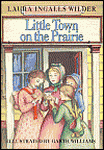Through the Looking Glass Children's Book Reviews
Little Town on the Prairie
Illustrator: Garth Williams
Historical Fiction Series
For ages 8 to 12
HarperCollins, 1953 ISBN: 978-0060264505
The long winter is finally over and the Ingalls family is now able to move out to their claim in the country once more. Soon everyone is busy working in the house and on the land. As she teaches the calf to drink milk, and as she goes for walks on the prairie, Laura keeps on hoping that they will somehow be able to make enough money so that Mary can go to college soon. It would be so wonderful for Mary to be able to go to a special college for the blind, where she can continue her studies and learn how to do many other things besides. So, when Laura is offered to job making shirts in town she takes it. Laura hates to sew and it is miserable having to spend the pretty days indoors, but she sticks with it, hoping that her earnings will help swell the college fund.
Though blackbirds and other creatures eat a good deal of Pa’s crops, the family manages to get the necessary money together, and in the fall Ma and Pa take Mary to the college for the blind in Iowa. Laura and her sisters miss Mary sorely, and the holidays just don’t seem right without their big sister. Laura keeps busy and she decides that she will work hard in school so that she can get her teacher’s certificate as soon as she turns sixteen. Laura does not really want to become a teacher, but she knows that the wages she earns doing such a job will ensure that Mary will be able to complete her college education.
Sometimes it is hard for Laura to keep this goal in mind for, as the town of De Smet grows, more and more activities fill the days. There are literary evenings, rides, a birthday party, and there is also a young man, Almanzo Wilder, who is making a point of spending time with Laura.
In this seventh book in the original Little House series, we come to realize that Laura is beginning that sometimes difficult transition into womanhood. It is amusing to ‘watch’ as she puts up her hair and gets a job on the one hand, and on the other she still likes to play ball games in the school yard with the “little boys.” We sympathize as she tries to do all she can to help Mary, and yet she cannot help wanting to have fun with her friends as well. We admire her as she makes many sacrifices to help those she loves, and we wonder at the way in which she does so with good grace and courage, never complaining about her lot.
In this marvelous book, Laura Ingalls Wilder once again brings her pioneer days alive, showing her readers what a hard life it was at times. And yet it was also a love-filled life, a life full of simple joys and special times.




